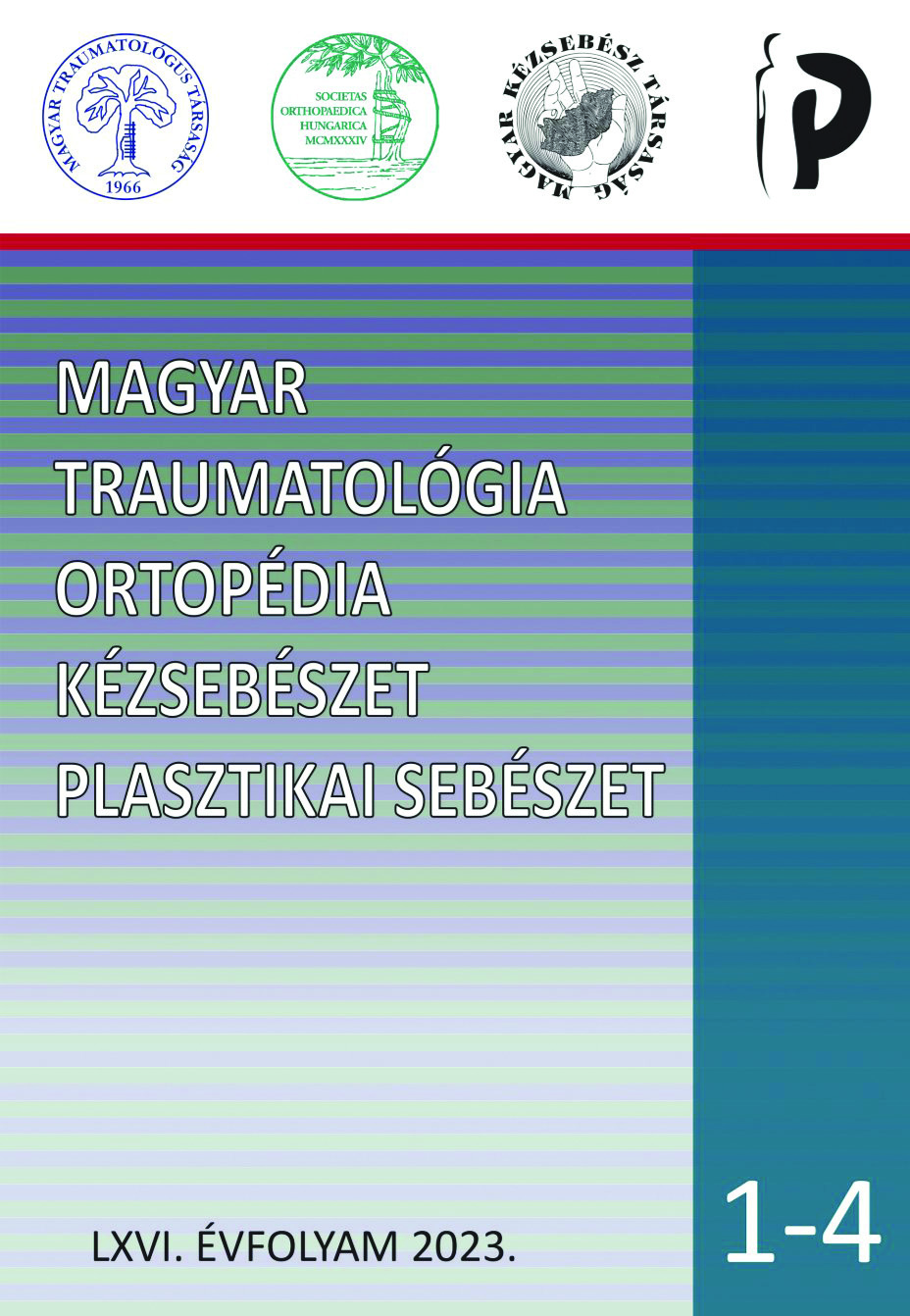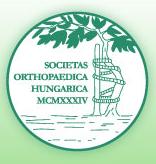Ízületi szögmérő használatának jelentősége Dupuytren betegségben
Absztrakt
A kéz ujjainak mozgástartományát progresszíven beszűkítő Dupuytren betegség ellátására definitív terápiás lehetőség jelenleg nincs, kezelése egy folyamat, amiben egy-egy beteg esetén több alkalommal kerülünk terápiás döntéshelyzetbe. Az ujjak ízületi mozgásainak pontosabban a nyújtás elmaradásának mértéke jellemzi a betegség mértékét. Egyéb kézbetegségek, sérülések utáni állapotok esetében is fontos a kéz funkciójának jellemzésére az ízületi mozgások pontos dokumentációja mind a károsodás, mind a gyógyulás megítélése céljából. Az ízületi szögmérés technikafüggő pontosságának/pontatlanságának mértéke a Dupyutren betegség esetén jól bemutatható. Itt ugyanis a progresszió és a recidívák pontos feltérképezése, utánkövetése elengedhetetlen része a terápiás tervezésnek. Ízületi szögmérő használata lehetőséget nyújt a pontos adatfelvételre, azonban használata a klinikai gyakorlatban nem történik meg konzekvensen. Kutatásunk célja volt, hogy felmérjük, mekkora pontatlansághoz vezet az ízületi szögmérő használatának mellőzése az ízületi szögek megítélésében, mindezt a Dupuytren betegségben példájával alátámasztva. Az adatgyűjtés során 97, különböző szakmai tapasztalattal rendelkező kollégáknak kontraktúrákat ábrázoló képeket mutattunk be, amelyeken az ízületi flexió mértékét kellett eszköz segítsége nélkül meghatározni. A jelentősebb munkatapasztalattal rendelkező szakorvosok átlagosan pontosabban becsültek rezidens és szakorvosjelölt társaikhoz viszonyítva, míg a szakmai terület alapján a kézsebészek voltak a legeredményesebbek. A betegvizsgálat során ízületi szögmérőt alkalmazó kollégák tippjei megbízhatóbbak voltak, mint a műszert nem alkalmazóké. Ízületi szögmérő nélkül pontos becslés az esetek egyötödében történt, ennek elhagyása a kontraktúrák mértékének megítélését egyértelműen pontatlanabbá teszi. A betegség lefolyásának (progresszió, recidívák) pontos megítélése csupán becslésre való hagyatkozás esetén az esetek túlnyomó többségében nem lehetséges, a szükséges precizitás elérésére a goniométer használatát javasoljuk.
Hivatkozások
Anwar M. U., Al Ghazal S. K., Boome R. S.: Results of surgical treatment of Dupuytren's disease in women: a review of 109 consecutive patients. J. Hand Surg. Am. 2007. 32. (9): 1423-1428. https://doi.org/10.1016/j.jhsa.2007.06.015
Aoun S. G., El Ahmadieh T. Y., El Tecle N. E., Daou M. R., Adel J. G., Park C. S., Batjer H. H., Bendok B. R.: A pilot study to assess the construct and face validity of the Northwestern Objective Microanastomosis Assessment Tool. J. Neurosurg. 2015. 123. (1): 103-109. https://doi.org/10.3171/2014.12.JNS131814
Bayat A., McGrouther D. A.: Management of Dupuytren's disease - clear advice for an elusive condition. Ann. R. Coll. Surg. Engl. 2006. 88. (1): 3-8. https://doi.org/10.1308/003588406X83104
Cook J. R. Baker N. A., Cham R., Hale E., Redfern M. S.: Measurements of wrist and finger postures: a comparison of goniometric and motion capture techniques. J. Appl. Biomech. 2007. 23. (1): 70-78. https://doi.org/10.1123/jab.23.1.70
Corkum J. P., Gillis J. A., Tang D. T.: Visual estimation of Dupuytren's flexion contractures - A prospective comparative trial. Plast. Surg. (Oakv). 2018. 26. (3): 165-168. https://doi.org/10.1177/2292550317750138
de Carvalho R. M., Mazzer N., Barbieri C. H.: Analysis of the reliability and reproducibility of goniometry compared to hand photogrammetry. Acta Ortop. Bras. 2012. 20. (3): 139-149. https://doi.org/10.1590/S1413-78522012000300003
Ellis B., Bruton A.: A study to compare the reliability of composite finger flexion with goniometry for measurement of range of motion in the hand. Clin. Rehabil. 2002. 16. (5): 562-570. https://doi.org/10.1191/0269215502cr513oa
Engstrand C.: Hand function in patients with Dupuytren's disease. Assessment, results and patients' perspectives. (Linköping University Medical Dissertations No. 1497). Linköping. Linköping University. 2016. https://doi.org/10.3384/diss.diva-125973
Engstrand C., Krevers B, Kvist J.: Interrater reliability in finger joint goniometer measurement in Dupuytren's disease. Am. J. Occup. Ther. 2012. 66. (1): 98-103. https://doi.org/10.5014/ajot.2012.001925
Luck J. V.: Dupuytren’s contracture; a new concept of the pathogenesis correlated with surgical management. J. Bone Joint Surg. Am. 1959. 41-A: 635-664. https://doi.org/10.2106/00004623-195941040-00008
Meyerding H.: Dupuytren’s contracture. Arch. Surg. 1936. 32: 320-333. https://doi.org/10.1001/archsurg.1936.01180200142007
Norotte G., Apoil A., Travers V.: A ten years follow-up of the results of surgery for Dupuytren's disease. A study of fifty-eight cases. Ann. Chir. Main. 1988. 7. (4): 277-281. https://doi.org/10.1016/S0753-9053(88)80024-3
Salamon A.: Dupuytren – Contractura. Budapest. Medicina Könyvkiadó Zrt. 2004.
Sennwald G. R.: Fasciectomy for treatment of Dupuytren’s disease and early complications. J. Hand Surg. Am. 1990. 15. (5): 755-761. https://doi.org/10.1016/0363-5023(90)90151-G
Smith R. P., Dias J. J., Ullah A., Bhowal B.: Visual and computer software-aided estimates of Dupuytren's contractures: Correlation with clinical goniometric measurements. Ann. R. Coll. Surg. Engl. 2009. 91. (4): 296-300. https://doi.org/10.1308/003588409X359259
Tubiana R., Michon J., Thomine J. M.: Scheme for the assessment of deformities in Dupuytren’s disease. Surg. Clin. North Am. 1968. 48. (5): 979-984. https://doi.org/10.1016/S0039-6109(16)38630-3











